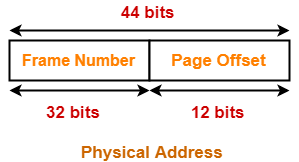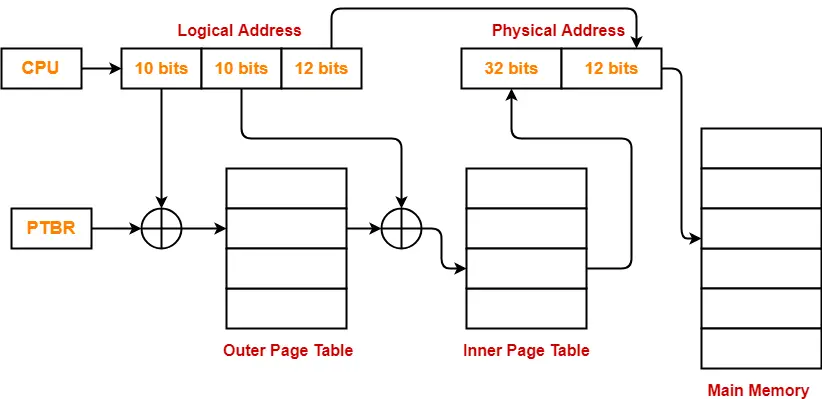Paging in OS-
Before you go through this article, make sure that you have gone through the previous article on Paging in OS.
We have discussed-
- Paging is a non-contiguous memory allocation technique.
- Page Table is a data structure that performs the mapping of page number to the frame number.
In this article, we will discuss about Multilevel Paging.
Multilevel Paging-
| Multilevel paging is a paging scheme where there exists a hierarchy of page tables. |
Need –
The need for multilevel paging arises when-
- The size of page table is greater than the frame size.
- As a result, the page table can not be stored in a single frame in main memory.
Working-
In multilevel paging,
- The page table having size greater than the frame size is divided into several parts.
- The size of each part is same as frame size except possibly the last part.
- The pages of page table are then stored in different frames of the main memory.
- To keep track of the frames storing the pages of the divided page table, another page table is maintained.
- As a result, the hierarchy of page tables get generated.
- Multilevel paging is done till the level is reached where the entire page table can be stored in a single frame.
Illustration of Multilevel Paging-
Consider a system using paging scheme where-
- Logical Address Space = 4 GB
- Physical Address Space = 16 TB
- Page size = 4 KB
Now, let us find how many levels of page table will be required.
Number of Bits in Physical Address-
Size of main memory
= Physical Address Space
= 16 TB
= 244 B
Thus, Number of bits in physical address = 44 bits
Number of Frames in Main Memory-
Number of frames in main memory
= Size of main memory / Frame size
= 16 TB / 4 KB
= 232 frames
Thus, Number of bits in frame number = 32 bits
Number of Bits in Page Offset-
We have,
Page size
= 4 KB
= 212 B
Thus, Number of bits in page offset = 12 bits
Alternatively,
Number of bits in page offset
= Number of bits in physical address – Number of bits in frame number
= 44 bits – 32 bits
= 12 bits
So, Physical address is-

Number of Pages of Process-
Number of pages the process is divided
= Process size / Page size
= 4 GB / 4 KB
= 220 pages
Inner Page Table Size-
Inner page table keeps track of the frames storing the pages of process.
Inner Page table size
= Number of entries in inner page table x Page table entry size
= Number of pages the process is divided x Number of bits in frame number
= 220 x 32 bits
= 220 x 4 bytes
= 4 MB
Now, we can observe-
- The size of inner page table is greater than the frame size (4 KB).
- Thus, inner page table can not be stored in a single frame.
- So, inner page table has to be divided into pages.
Number of Pages of Inner Page Table-
Number of pages the inner page table is divided
= Inner page table size / Page size
= 4 MB / 4 KB
= 210 pages
Now, these 210 pages of inner page table are stored in different frames of the main memory.
Number of Page Table Entries in One Page of Inner Page Table-
Number of page table entries in one page of inner page table
= Page size / Page table entry size
= Page size / Number of bits in frame number
= 4 KB / 32 bits
= 4 KB / 4 B
= 210
Number of Bits Required to Search an Entry in One Page of Inner Page Table-
One page of inner page table contains 210 entries.
Thus,
Number of bits required to search a particular entry in one page of inner page table = 10 bits
Outer Page Table Size-
Outer page table is required to keep track of the frames storing the pages of inner page table.
Outer Page table size
= Number of entries in outer page table x Page table entry size
= Number of pages the inner page table is divided x Number of bits in frame number
= 210 x 32 bits
= 210 x 4 bytes
= 4 KB
Now, we can observe-
- The size of outer page table is same as frame size (4 KB).
- Thus, outer page table can be stored in a single frame.
- So, for given system, we will have two levels of page table.
- Page Table Base Register (PTBR) will store the base address of the outer page table.
Number of Bits Required to Search an Entry in Outer Page Table-
Outer page table contains 210 entries.
Thus,
Number of bits required to search a particular entry in outer page table = 10 bits
The paging system will look like as shown below-

PRACTICE PROBLEM BASED ON MULTILEVEL PAGING-
Problem-
Consider a system using multilevel paging scheme. The page size is 16 KB. The memory is byte addressable and virtual address is 48 bits long. The page table entry size is 4 bytes.
Find-
- How many levels of page table will be required?
- Give the divided physical address and virtual address.
Solution-
Given-
- Virtual Address = 48 bits
- Page size = 16 KB
- Page table entry size = 4 bytes
Number of Bits in Frame Number-
We have,
Page table entry size
= 4 bytes
= 32 bits
Thus, Number of bits in frame number = 32 bits
Number of Frames in Main Memory-
We have, Number of bits in frame number = 32 bits
Thus,
Number of frames in main memory
= 232 frames
Size of Main Memory-
Size of main memory
= Total number of frames x Frame size
= 232 x 16 KB
= 246 B
= 64 TB
Thus, Number of bits in physical address = 46 bits
Number of Bits in Page Offset-
We have,
Page size
= 16 KB
= 214 B
Thus, Number of bits in page offset = 14 bits
Alternatively,
Number of bits in page offset
= Number of bits in physical address – Number of bits in frame number
= 46 bits – 32 bits
= 14 bits
Process Size-
Number of bits in virtual address = 48 bits
Thus,
Process size
= 248 bytes
= 256 TB
Number of Pages of Process-
Number of pages the process is divided
= Process size / Page size
= 256 TB / 16 KB
= 248 B / 214 B
= 234 pages
Inner Page Table Size-
Inner page table keeps track of the frames storing the pages of process.
Inner Page table size
= Number of entries in inner page table x Page table entry size
= Number of pages the process is divided x Page table entry size
= 234 x 4 bytes
= 236 bytes
= 64 GB
Now, we can observe-
- The size of inner page table is greater than the frame size (4 KB).
- Thus, inner page table can not be stored in a single frame.
- So, inner page table has to be divided into pages.
Number of Pages of Inner Page Table-
Number of pages the inner page table is divided
= Inner page table size / Page size
= 64 GB / 16 KB
= 236 B / 214 B
= 222 pages
Now, these 222 pages of inner page table are stored in different frames of the main memory.
Number of Page Table Entries in One Page of Inner Page Table-
Number of page table entries in one page of inner page table
= Page size / Page table entry size
= 16 KB / 4 B
= 212 entries
Number of Bits Required to Search an Entry in One Page of Inner Page Table-
One page of inner page table contains 212 entries.
Thus,
Number of bits required to search a particular entry in one page of inner page table = 12 bits
Outer Page Table-1 Size-
Outer page table-1 is required to keep track of the frames storing the pages of inner page table.
Outer Page table-1 size
= Number of entries in outer page table-1 x Page table entry size
= Number of pages the inner page table is divided x Page table entry size
= 222 x 4 bytes
= 16 MB
Now, we can observe-
- The size of outer page table-1 is greater than the frame size (4 KB).
- Thus, outer page table-1 can not be stored in a single frame.
- So, outer page table-1 has to be divided into pages.
Number of Pages of Outer Page Table-1
Number of pages the outer page table-1 is divided
= Outer page table-1 size / Page size
= 16 MB / 16 KB
= 210 pages
Now, these 210 pages of outer page table-1 are stored in different frames of the main memory.
Number of Page Table Entries in One Page of Outer Page Table-1
Number of page table entries in one page of outer page table-1
= Page size / Page table entry size
= 16 KB / 4 B
= 212 entries
Number of Bits Required to Search an Entry in One Page of Outer Page Table-1
One page of outer page table-1 contains 212 entries.
Thus,
Number of bits required to search a particular entry in one page of outer page table-1 = 12 bits
Outer Page Table-2 Size-
Outer page table-2 is required to keep track of the frames storing the pages of outer page table-1.
Outer Page table-2 size
= Number of entries in outer page table-2 x Page table entry size
= Number of pages the outer page table-1 is divided x Page table entry size
= 210 x 4 bytes
= 4 KB
Now, we can observe-
- The size of outer page table-2 is less than the frame size (16 KB).
- Thus, outer page table-2 can be stored in a single frame.
- In fact, outer page table-2 will not completely occupy one frame and some space will remain vacant.
- So, for given system, we will have three levels of page table.
- Page Table Base Register (PTBR) will store the base address of the outer page table-2.
Number of Bits Required to Search an Entry in Outer Page Table-2
Outer page table-2 contains 210 entries.
Thus,
Number of bits required to search a particular entry in outer page table-2 = 10 bits
The paging system will look like as shown below-

Important Points-
- At any level, the page table entry size of any page table will always be same because each entry points to the frame number.
- When there is only one level of paging, there is only one page table whose size is less than or equal to page size.
- All the page tables are completely filled except possibly the last page.
To gain better understanding about Multilevel Paging,
Next Article- Practice Problems On Multilevel Paging
Get more notes and other study material of Operating System.
Watch video lectures by visiting our YouTube channel LearnVidFun.

